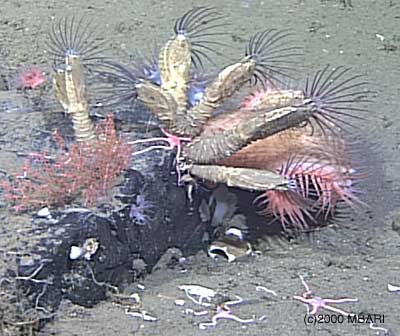



 |
Deep-sea gooseneck barnacles attaced to a rock at the sea floor. Notice the crouding of many animals (brittle stars, gorgonians, anemones, and tube worms) on the small amount of hard substrate available on the soft mud sea floor. Video framegrab taken with the ROV Ventana and provided by the Monterey Bay Aquarium Research Institute. |
Adult cirripeds are not mobile unless they attach to a mobile substrate such as whales, logs, or buoys. Larvae on the other hand, swim for a length of time before carefully choosing a place to attach. The tiny larvae may land on and examine several substrates before choosing one they like and finally attach. Choosing a good location to attach is particularly important to barnacles (attached or unmoving) animals because they require internal fertilization. Most sessile (attached or not mobile) aquatic animals release their eggs and sperm into the water and fertilization takes place outside the body but barnacles, like other arthropods, have to place sperm into the female for the eggs to be fertilized. Even though barnacles are hermaphroditic (having both male and female gonads) they never fertilize their own eggs. Once attached the animal is essentially sitting on its head, begins metamorphosis and begins secreting the calcareous plates that surround and protect it from many predators.
